The chest is the most common and fundamental item of medieval furniture.
Wealthy nobles would own hundreds upon hundreds of chests, as shown by wills and
death-rolls.1 Chests in the Middle Ages served simultaneously as both
furniture and luggage. Chests were the most important furniture item of the
medieval noble household.
Chests are also the most useful items of medieval furniture we can make for
use in the SCA. As the great nobles in the Middle Ages travelled from manor to
manor, we travel from event to event and must store our SCA goods in the
meantime. This article is a survey of chest construction and decoration
techniques in the hope of inspiring woodworkers to build more medieval
chests.
Types of Medieval Chest
This article examines the six general styles or classes of medieval chest:
box, standard, Viking chest, six-board chest, hutch, and panel chest. The first
two classes (box and standard) are legless designs; the other four (Viking,
six-board, hutch, and panel chest) are designs with legs.
The designs of chests were heavily influenced by their intended use. Designs
without feet or legs were easier for travelling, especially by cart or wagon.
Designs with legs kept their contents much cleaner and were less subject to the
filth and vermin of medieval floors. Extensive decoration is rare on chests
designed for travelling, as it would easily become damaged and marred.
Travelling chests often had hipped or curved lids to shed water. Chests intended
for static storage purposes usually had flat lids, which would make them more
useful as furniture for seating or other purposes. Travelling chests were often
covered in waxed leather to improve their weather resistance.
As with many medieval artifacts, chests were often extensively decorated. The
decoration of a chest might be a simple and standardized design, mass produced
by a single workshop. A chest dated to c. 1300 in the Victoria and Albert Museum
is one of a closely related family of chests found largely in Sussex and Surrey,
probably all created by the same guild or workshop, all decorated nearly
identically.4
On the other hand, decoration unique to a particular chest also appears in
surviving examples. The `Fares' chest (in the Victoria and Albert Museum) shows
a number of unique features. The back of the chest (where the hinges attach) is
much more heavily decorated than the front (where the lock-plate was). One end
of the chest is heavily carved, the other end is left rough. This chest was
clearly designed for use in a specific place, probably a workshop or guildhall
where it would be facing the customers, one end flush against a wall.5
Oak was the favorite material for medieval chests, as for most other medieval
furniture. Walnut was another common wood for chests in France, but not in
England.6 Chests were sometimes made of poplar or pine, and several softwood
chests survive from what is now Germany.
The changes in the types of chests used seems to have been driven by two
major forces: improvements in joinery, and changes in society. Improvements in
joinery led the simple six-board and Viking chest to be replaced by the hutch,
and the hutch to be replaced by the panel chest. Changes in society led to a
change in focus from the mobile, furniture-poor society of the early Middle
Ages, to the more settled society of the Rennaissance. This changed the focus of
the chest from primarily a travelling container to primarily a storage container
with a secondary display function. In keeping with this new role chests became
heavily decorated with intricate carving, and most lids became flat instead of
curved.
In addition to the six main designs this article will briefly touch on four
less common forms: dugout chests, arks, dovetail-joint chests, and cassoni.
Box
Boxes are simple flat-lidded travelling chests. The construction is very
simple, with a single board for each side, bottom, and the lid (six boards
total). The boards are simply butted against each other and nailed together.
Since this is a very weak joint boxes often used simple iron straps as
reinforcements. Because they are intended as travelling chests, boxes have no
legs and are usually undecorated.
Standard
This is perhaps the most common, and universal, design of chest, and the best
overall travelling chest. Like the box, the bottom of a standard is simple and
legless. The top is smoothly curved, often overlapping the sides, front, and
back. This curved overlapping top allows the standard to shed rain during
travel. Like the box, the standard just has butted and nailed boards, and
therefore it, too, almost always shows heavy use of metal strapping and
reinforcements. As a travelling chest, it is usually undecorated. Standards were
sometimes covered in leather for weatherproofing.
Viking Chest
 The Viking chest is very similar to the six-board chest. The two end pieces
are extended down to form slab legs, raising the chest off the floor (or ship
deck). Instead of the simple overlap design used in the six-board chest, where
the front is nailed to the end-piece, Viking chests have both the front and
end-piece overlapping each other, so nails reinforced the joint in both
directions.
The Viking chest is very similar to the six-board chest. The two end pieces
are extended down to form slab legs, raising the chest off the floor (or ship
deck). Instead of the simple overlap design used in the six-board chest, where
the front is nailed to the end-piece, Viking chests have both the front and
end-piece overlapping each other, so nails reinforced the joint in both
directions.  Although this is a better joint than the simple lap of the six-board
chest, the resulting joint is still not very durable, and Viking chests often
show the use of metal reinforcing straps. The floor of the chest is seated in a
dado joint cut in the end boards, as shown in Figure 5.
Although this is a better joint than the simple lap of the six-board
chest, the resulting joint is still not very durable, and Viking chests often
show the use of metal reinforcing straps. The floor of the chest is seated in a
dado joint cut in the end boards, as shown in Figure 5.
Viking chests are usually made to be a good height for seating, and may have
been used as rowing benches in Viking warships.8 Many Viking chests were
travelling chests, and usually have lids that are hollowed out of thicker planks
so they are curved to shed rain and weather.
The few surviving Viking chests I have found are undecorated, although
sometimes the iron strapwork is decorated with tinned nails or incised designs.
The Vikings carved many items of wood (ships, churches, sleds, beds, chairs), so
it is reasonable that chests were also decorated with carving, but I have no
evidence at this time. Without evidence to the contrary, low relief or incised
carving seem likely to be appropriate decoration for a Viking chest.
Six-board Chest
 This is perhaps the most common household chest design throughout the period
examined. The construction is extremely simple: five flat boards make up the
bottom, sides, and ends, and another flat board forms the lid. The two end
boards are extended to raise the chest off the ground on a pair of slab legs.
Six-board chests might be undecorated, or highly decorated with painting or
carving. Some of them are extensively covered with metal strapping to reinforce
their fairly simple and weak joinery, but others show little or no metalwork.
This is perhaps the most common household chest design throughout the period
examined. The construction is extremely simple: five flat boards make up the
bottom, sides, and ends, and another flat board forms the lid. The two end
boards are extended to raise the chest off the ground on a pair of slab legs.
Six-board chests might be undecorated, or highly decorated with painting or
carving. Some of them are extensively covered with metal strapping to reinforce
their fairly simple and weak joinery, but others show little or no metalwork.
Six-board chests involved nailing the sides to the end pieces in a simple lap
joint. The chest floor is attached to the end pieces with a dado joint, exactly
as shown for the Viking chest in Figure 5. As with the Viking chest (and perhaps
even more so), the corner joints are quite weak. Because of the weakness of the
joinery six-board chests were often braced with metal straps at the corners, as
illustrated in Figure 6.
Six-board chests are common from the 9th through the sixteenth centuries and
later. The longevity of the design is probably related to its simplicity. More
complex and durable joinery existed from the end of the Viking period, but these
chests would have been much simpler to make, and therefore cheaper, which
explains their survival throughout the period examined and into the seventeenth
century.
This most common and long-lasting chest design shows a number of decorative
techniques. Few early chests survive, so decoration techniques before 1200 are
merely supposition, but designs like those discussed above for Viking chests
would probably be appropriate. For later chests, whatever decoration technique
was most common in a given period was likely to be used upon six-board chests of
that period. This was true even when the decoration technique was inappropriate
for the medium; the front of one surviving six-board chest is wholly covered in
low-relief carving typical of the fourteenth century.9 Undecorated six-board
chests seem to be rare, and limited to early period, but this could be because
surviving chests are much more likely to be those that were richly decorated and
carefully treasured through the ages, rather than utilitarian articles that were
used until broken, then discarded.
|
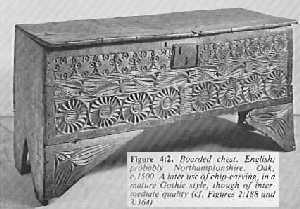
|
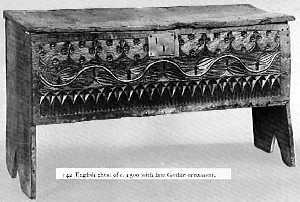
|
| Six board chest, c. 1500 |
Another c. 1500 six board chest. |
Hutch
The hutch was the first great advance of joinery from the simple nailed
six-board and Viking chests.  Instead of the slab legs of the six-board chest,
made by extending the end pieces down to the floor, the hutch added extensions
(stiles) to lengthen the front and back pieces, and extended the stiles down to
the ground to make four legs. The end-pieces and front pieces are joined to the
stiles with a pegged tongue-and-groove joint. Sometimes braces are used in the
end pieces for additional strength. The lids are usually flat, but may be
slightly angled. The hutch design of pegged tongue-and-groove joinery is far
more durable than the nailed or pegged lap joints of the six-board chest.
Although decorative strapping continues to appear on hutches, it is less
prevalent and appears to take the form of a couple of long straps, fewer and
more decorative than on six-board chests.
Instead of the slab legs of the six-board chest,
made by extending the end pieces down to the floor, the hutch added extensions
(stiles) to lengthen the front and back pieces, and extended the stiles down to
the ground to make four legs. The end-pieces and front pieces are joined to the
stiles with a pegged tongue-and-groove joint. Sometimes braces are used in the
end pieces for additional strength. The lids are usually flat, but may be
slightly angled. The hutch design of pegged tongue-and-groove joinery is far
more durable than the nailed or pegged lap joints of the six-board chest.
Although decorative strapping continues to appear on hutches, it is less
prevalent and appears to take the form of a couple of long straps, fewer and
more decorative than on six-board chests.
Hutches
first appeared in the thirteenth century. They became the dominant form (at
least for expensive, fashionable chests) in the fourteenth and fifteenth
centuries. By the sixteenth century the panel chest, a design that is lighter
than the hutch but just as durable, took over and replaced the hutch, which
quickly disappeared
 Because of the sturdiness of the hutch design little or no additional
reinforcement is necessary, leaving the whole of the face available for
decoration. Many surviving examples of the hutch are extensively carved. The
feet of the chest are also common subjects for relief carving (arcading) or
cutaway designs. The face of the hutch is commonly covered with carving
appropriate to the period: chip-carved roundels in the thirteenth century, the
relief-carved scenes of the fourteenth and fifteenth centuries, or the elaborate
tracery of the late fifteenth century.
Because of the sturdiness of the hutch design little or no additional
reinforcement is necessary, leaving the whole of the face available for
decoration. Many surviving examples of the hutch are extensively carved. The
feet of the chest are also common subjects for relief carving (arcading) or
cutaway designs. The face of the hutch is commonly covered with carving
appropriate to the period: chip-carved roundels in the thirteenth century, the
relief-carved scenes of the fourteenth and fifteenth centuries, or the elaborate
tracery of the late fifteenth century.
|
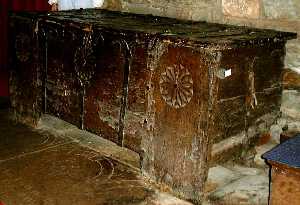
|
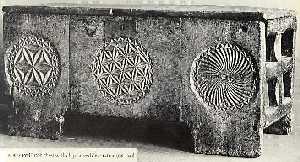
|
|
This surviving chest is in Laneham Church,
Nottinghamshire, England. For more photos on this chest, taken by
Master Terafan during a trip, follow
this link... |
13th century hutch chest |
Panel Chest
 The panel chest is a sixteenth century evolution from the hutch. Instead of
the hutch design where the sides and ends are constructed of single boards
attached to stiles by pegged tongue-and-groove joints, the panel chest uses
pegged tongue-and-groove to create a hollow grooved frame that holds a thinner,
lighter panel. The stiles often evolve to be corner posts. Panel chests have
flat lids. The panels are usually extensively carved, often with linenfold
carving. Panel chests quickly become the dominant form in the sixteenth century,
although (like the hutch) they fail to eliminate the much cheaper and simpler
six-board chests.
The panel chest is a sixteenth century evolution from the hutch. Instead of
the hutch design where the sides and ends are constructed of single boards
attached to stiles by pegged tongue-and-groove joints, the panel chest uses
pegged tongue-and-groove to create a hollow grooved frame that holds a thinner,
lighter panel. The stiles often evolve to be corner posts. Panel chests have
flat lids. The panels are usually extensively carved, often with linenfold
carving. Panel chests quickly become the dominant form in the sixteenth century,
although (like the hutch) they fail to eliminate the much cheaper and simpler
six-board chests.
Decoration of panel chests is usually focussed upon the panels themselves,
with the frame undecorated or merely engraved with linear forms. The elaborate
tracery of the later fifteenth century and the linenfold techniques of the early
sixteenth both show up on panel chests.
|
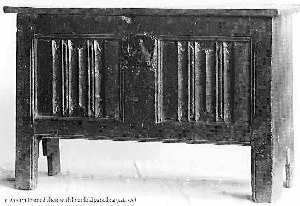
|
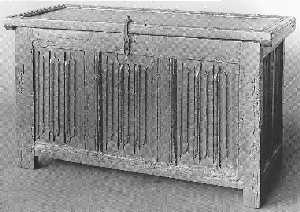
|
| Early 16th century linenfold chest |
English linenfold chest, c. 1500 |
Dugout
 Dugout chests may be the oldest design of all. No joinery is required--you
just cut a log in two lengthwise, then hollow out both halves to make a chest.
Chests constructed in this way are very heavy, and take a long time to make.
Even so, a few surviving examples show that chests were still being made this
way in the early Middle Ages and possibly even into the seventeenth century.11
Dugout chests may be the oldest design of all. No joinery is required--you
just cut a log in two lengthwise, then hollow out both halves to make a chest.
Chests constructed in this way are very heavy, and take a long time to make.
Even so, a few surviving examples show that chests were still being made this
way in the early Middle Ages and possibly even into the seventeenth century.11
Very few examples of this type of chest survive, making it hard to generalize
about their decoration (or lack thereof). Their heavy, legless design seems
unsuitable for carving or other decoration, but this is mere supposition. Iron
straps appear in both the surviving examples shown in Chinnery.12
Ark
The ark is a variation of the hutch style of chest. Although few surviving
examples survive, they seem to appear fairly early (in the thirteenth century).
Unlike any other type of chest described here, the ark was constructed with
riven (split) oak, rather than sawn boards. The design seems to have changed
very little in the hundreds of years it was used (up until the seventeenth
century). Arks were constructed with pegged tenons in through-mortises. Arks
always show an angled lid with raised flanges at the ends, and extended stile
legs similar to those of hutches. Arks seem to have been usually undecorated.13
The ark design is quite sturdy, with its pegged tenons and riven planks. No
metal strap reinforcements are necessary, and none of the surviving arks show
any sign of metalwork. Figure 2. illustrates an ark style chest.
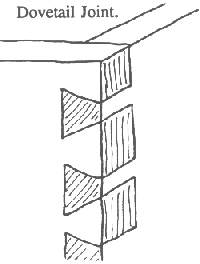 Dovetail Chest
Dovetail Chest
Dovetail joinery first appears in the fifteenth century as an alternative
method of attaching the ends of a chest to the sides. Numerous examples exist,
but this was not as common a technique as the hutch. Dovetail chests cannot use
the extended-stile design of the hutch, and so dovetail chests never have legs.
Probably because of its difficulty (and therefore cost), Dovetail joinery never
became the dominant construction technique, and when the panel chest began
appearing in the sixteenth century dovetail-joined chests largely disappear.
Figure 14 Small Dovetail-joint Chest.14
The dovetail-joined chests of the fifteenth century were very well suited to
complex tracery carving over the whole face. Hutches also sometimes exhibit
extraordinary carving, but the differing grain direction at the stiles
complicates such carving. Many of the finest examples of fifteenth century
carving are on dovetail-joined chests.
Cassoni
Cassoni are painted Italian marriage caskets. They were beautifully painted
over the whole surface, often very large, and had an architectural motif.
Considering their size and extensive decoration cassoni were clearly not
constructed for travel. Numerous examples exist from the fourteenth and
fifteenth centuries.
The durability of the joinery in cassoni was much less important than in
other types of chests because they were intended to be stationary furniture with
the main purpose of ostentatious display. Cassoni were covered with glued-down
leather or cloth, primed with several layers of gesso, and painted over their
whole surface. This makes it very hard to determine the joinery underlying the
paint on surviving examples.
Cassoni in the fourteenth and fifteenth centuries were wholly painted in
great detail and subtlety, similar in style and content to frescoes. In the
sixteenth century other decoration techniques replaced painting. Some of these
techniques were metal embossed sheeting as illustrated in Figure 15., parquetry
and inlay, and fantastic architectural motifs.
|
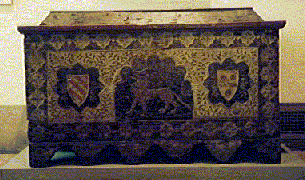
|
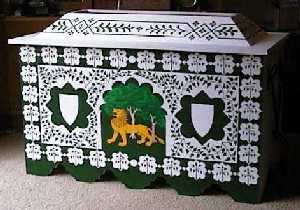
|
| Italian cassone in the Philadelphia
Museum of Art |
Reproduction Italian cassone by Master
Terafan and Master Dafydd. For more details on the reproduction, follow
this link... |
Timeline: Chests and Decoration by Century
Pre 1200
The six-board and Viking chests dominate. Carving is probably incised
low-relief with the addition of paint, as shown in Figure 1, and may be
infrequent. Reinforcing ironwork is common and often decorative.
Thirteenth Century
Hutches appear and become ubiquitous. Decorative ironwork and reinforcing
straps are relatively common, as illustrated in Figure 3. Carving techniques
used are simple arcading and chip carving. Painting is fairly common, sometimes
on chip-carved chests, sometimes heraldic designs and miniatures.
Fourteenth Century
Hutches begin to have complex carved scenes on them, replacing the
chip-carved roundels common in the thirteenth century. Reinforcing straps begin
to disappear on chests and decorative ironwork is uncommon.
Fifteenth Century
Hutches with relief-carved scenes reach their height (as shown in Figure 10),
but they begin to see competition from complex ornamental tracery and dovetailed
boxes (see Figure 14). Only travelling and utility chests seem to be without
carved ornamentation. Decorative ironwork is rare. This period is the height of
the chest-carver's art, with fantastic decorative ornamentation, whether gothic
tracery or relief-carved scenes from famous stories from literature or religion.
Sixteenth Century
Panel chests dominate; various carving techniques are used to decorate the
panels. Linenfold panels and other relatively simple methods quickly replace the
complex tracery of the fifteenth century.
Notes
- Eames, Penelope, Furniture in England, France and the Netherlands from the
Twelfth to the Fifteenth Century, (London: Furniture History Society, 1977),
page 109.
- Viking Chest. Reproduction constructed by the author appropriate for the
ninth or tenth century. Photograph 1995 by the author.
- Ark. Sixteenth century reproduction. Bayleaf Hall, Weald and Downland Open
Air Museum, Sussex. Photograph 1995 by the author.
- Tracy, Charles, English Medieval Furniture and Woodwork, (London: Victoria
and Albert Museum), pages 172 to 174. Chinnery, figure 4:1, and Mercer,
figure 27, also show the chest currently in the Victoria and Albert Museum.
- Tracy, page 178.
- Eames, page 135.
- Hutch. Tower of London. Reproduction of a hutch in the Musee des Arts
Decoratifs, c. 1200-50. Photograph 1995 by the author.
- The Viking, (New York: Crescent Books, 1975), page 186.
- Mercer, Eric, Furniture 700-1700, (Des Moines and New York: Meredith
Press, 1969), figure 91.
- Relief-carved Chest Panel. Elm, c. 1400, in the London Museum. A scene
from Chaucer, the Pardoner's Tale. Photograph 1995 by the author.
- Chinnery, Victor, Oak Furniture, (Woodbridge, Suffolk: Antique Collectors'
Club, 1979), pages 69-71, mentions and illustrates both chests, and
discusses the later chest at length.
- Chinnery, figures 2:35, 2:36, 2:35, and 2:37.
- Chinnery, pp356-358; figures 3:359, 3:360. Another example is shown in
Tracey, page 176. A 16th century example decorated with simple incised lines
is shown in Wolsey, S. W., and Luff, R. W. P., Furniture in England: The Age
of the Joiner, (New York and Washington: Frederick A. Praeger, 1968), figure
2.
- Small Dovetail-joined Chest. French, c. 1500, Philadelphia Museum of Art.
Photograph 1995 by the author.
- Cassone. Italian, Sixteenth Century, Victoria and Albert Museum.
Photograph 1991 by Peter Adams and Kitten Reames.
 The Viking chest is very similar to the six-board chest. The two end pieces
are extended down to form slab legs, raising the chest off the floor (or ship
deck). Instead of the simple overlap design used in the six-board chest, where
the front is nailed to the end-piece, Viking chests have both the front and
end-piece overlapping each other, so nails reinforced the joint in both
directions.
The Viking chest is very similar to the six-board chest. The two end pieces
are extended down to form slab legs, raising the chest off the floor (or ship
deck). Instead of the simple overlap design used in the six-board chest, where
the front is nailed to the end-piece, Viking chests have both the front and
end-piece overlapping each other, so nails reinforced the joint in both
directions.  Although this is a better joint than the simple lap of the six-board
chest, the resulting joint is still not very durable, and Viking chests often
show the use of metal reinforcing straps. The floor of the chest is seated in a
dado joint cut in the end boards, as shown in Figure 5.
Although this is a better joint than the simple lap of the six-board
chest, the resulting joint is still not very durable, and Viking chests often
show the use of metal reinforcing straps. The floor of the chest is seated in a
dado joint cut in the end boards, as shown in Figure 5. This is perhaps the most common household chest design throughout the period
examined. The construction is extremely simple: five flat boards make up the
bottom, sides, and ends, and another flat board forms the lid. The two end
boards are extended to raise the chest off the ground on a pair of slab legs.
Six-board chests might be undecorated, or highly decorated with painting or
carving. Some of them are extensively covered with metal strapping to reinforce
their fairly simple and weak joinery, but others show little or no metalwork.
This is perhaps the most common household chest design throughout the period
examined. The construction is extremely simple: five flat boards make up the
bottom, sides, and ends, and another flat board forms the lid. The two end
boards are extended to raise the chest off the ground on a pair of slab legs.
Six-board chests might be undecorated, or highly decorated with painting or
carving. Some of them are extensively covered with metal strapping to reinforce
their fairly simple and weak joinery, but others show little or no metalwork.


 Instead of the slab legs of the six-board chest,
made by extending the end pieces down to the floor, the hutch added extensions
(stiles) to lengthen the front and back pieces, and extended the stiles down to
the ground to make four legs. The end-pieces and front pieces are joined to the
stiles with a pegged tongue-and-groove joint. Sometimes braces are used in the
end pieces for additional strength. The lids are usually flat, but may be
slightly angled. The hutch design of pegged tongue-and-groove joinery is far
more durable than the nailed or pegged lap joints of the six-board chest.
Although decorative strapping continues to appear on hutches, it is less
prevalent and appears to take the form of a couple of long straps, fewer and
more decorative than on six-board chests.
Instead of the slab legs of the six-board chest,
made by extending the end pieces down to the floor, the hutch added extensions
(stiles) to lengthen the front and back pieces, and extended the stiles down to
the ground to make four legs. The end-pieces and front pieces are joined to the
stiles with a pegged tongue-and-groove joint. Sometimes braces are used in the
end pieces for additional strength. The lids are usually flat, but may be
slightly angled. The hutch design of pegged tongue-and-groove joinery is far
more durable than the nailed or pegged lap joints of the six-board chest.
Although decorative strapping continues to appear on hutches, it is less
prevalent and appears to take the form of a couple of long straps, fewer and
more decorative than on six-board chests. Because of the sturdiness of the hutch design little or no additional
reinforcement is necessary, leaving the whole of the face available for
decoration. Many surviving examples of the hutch are extensively carved. The
feet of the chest are also common subjects for relief carving (arcading) or
cutaway designs. The face of the hutch is commonly covered with carving
appropriate to the period: chip-carved roundels in the thirteenth century, the
relief-carved scenes of the fourteenth and fifteenth centuries, or the elaborate
tracery of the late fifteenth century.
Because of the sturdiness of the hutch design little or no additional
reinforcement is necessary, leaving the whole of the face available for
decoration. Many surviving examples of the hutch are extensively carved. The
feet of the chest are also common subjects for relief carving (arcading) or
cutaway designs. The face of the hutch is commonly covered with carving
appropriate to the period: chip-carved roundels in the thirteenth century, the
relief-carved scenes of the fourteenth and fifteenth centuries, or the elaborate
tracery of the late fifteenth century.

 The panel chest is a sixteenth century evolution from the hutch. Instead of
the hutch design where the sides and ends are constructed of single boards
attached to stiles by pegged tongue-and-groove joints, the panel chest uses
pegged tongue-and-groove to create a hollow grooved frame that holds a thinner,
lighter panel. The stiles often evolve to be corner posts. Panel chests have
flat lids. The panels are usually extensively carved, often with linenfold
carving. Panel chests quickly become the dominant form in the sixteenth century,
although (like the hutch) they fail to eliminate the much cheaper and simpler
six-board chests.
The panel chest is a sixteenth century evolution from the hutch. Instead of
the hutch design where the sides and ends are constructed of single boards
attached to stiles by pegged tongue-and-groove joints, the panel chest uses
pegged tongue-and-groove to create a hollow grooved frame that holds a thinner,
lighter panel. The stiles often evolve to be corner posts. Panel chests have
flat lids. The panels are usually extensively carved, often with linenfold
carving. Panel chests quickly become the dominant form in the sixteenth century,
although (like the hutch) they fail to eliminate the much cheaper and simpler
six-board chests.

 Dugout chests may be the oldest design of all. No joinery is required--you
just cut a log in two lengthwise, then hollow out both halves to make a chest.
Chests constructed in this way are very heavy, and take a long time to make.
Even so, a few surviving examples show that chests were still being made this
way in the early Middle Ages and possibly even into the seventeenth century.11
Dugout chests may be the oldest design of all. No joinery is required--you
just cut a log in two lengthwise, then hollow out both halves to make a chest.
Chests constructed in this way are very heavy, and take a long time to make.
Even so, a few surviving examples show that chests were still being made this
way in the early Middle Ages and possibly even into the seventeenth century.11 Dovetail Chest
Dovetail Chest
